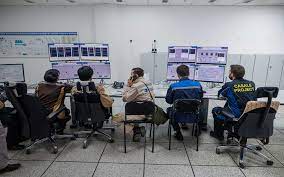
One of the most important procedures is transaction monitoring in anti-money laundering. As a result, it tries to help the economy combat common risks including funding for terrorism, the sale of guns, human trafficking, and corruption. Any company that could assist in money laundering must make sure that it complies with all legal standards.
Every business needs transaction monitoring because it offers a proactive defense against cyber threats, safeguards money and customer information, maintains compliance with laws, reduces operational risks, and enables businesses to keep ahead of fraud strategies that are constantly evolving.
Example of a Transaction Monitoring System
Transaction monitoring plays a crucial role in detecting and preventing money laundering activities.
Let’s imagine that a reputable transaction monitoring system has been put in place by a financial institution such as any ABC Bank. On the basis of pre-established rules and algorithms, the system is built to flag and look into questionable transactions.
Large Cash Deposits: Based on his reported income and spending habits, the transaction monitoring system notices a person, let’s call him George, who consistently puts sizable amounts of cash into his account. This behavior raises a concern.
Structuring Transactions: After additional analysis of George’s deposits, the system notices a pattern of structured deposits, a series of smaller deposits made on various days or branches, all falling just short of the amount that would automatically result in reporting to regulatory authorities.
Unusual Financial Activities: The system also looks at the business dealings of companies connected to George. It names a number of shell businesses and dormant entities under his control that are receiving money from unconnected sources and then transferring it through different channels.
Adverse News or Regulatory notifications: Through integration with external databases, the transaction monitoring system is able to receive notifications concerning unfavorable news or regulatory actions pertaining to the people or businesses involved in transactions. In this instance, it is found that one of the companies connected to George has a history of being involved in money-laundering activities.
Building Trust and Confidence: The Impact of KYC Transactions and Customer Due Diligence
Better AML and CTF Efforts: Customer due diligence and KYC transactions are part of the overall effort to fight money laundering and terrorist financing. Financial institutions can spot and report suspicious behaviors to the proper authorities by carefully validating customer identities, comprehending their business activities, and closely monitoring their transactions. Effective KYC and CDD procedures serve as a deterrent for criminals who might try to exploit the financial system.
Strong KYC transactions and customer due diligence aid in fostering consumer trust and confidence in today’s era of rising financial crimes and data breaches.
Role of KYT and Risk based Transaction Monitoring in Financial Institutions
Securing the Financial System: KYT and Risk-Based Transaction Monitoring as Key Tools against Financial Crimes
The mitigation of financial crimes, including money laundering, terrorist financing, fraud, and other illicit activities, relies heavily on the crucial contributions of both Know Your Transaction and risk-based transaction monitoring. These approaches involve the ongoing monitoring of transactions and the analysis of associated risks to identify any suspicious activities, patterns, or anomalies that may signify potential financial crimes. By promptly detecting such indicators, financial institutions are able to take necessary measures to prevent or disrupt these activities effectively.
Why Every Company Needs Fraud Transaction Monitoring?
Have questions about fraud monitoring?
As our society embraces the convenience of a digital world, cybercriminals are finding new avenues to exploit digital transactions. In 2021 alone, over $5.8 billion was reported lost to fraud by more than 2.8 million consumers, representing a staggering 70% increase compared to the previous year.
PwC’s research reveals that the primary danger originates from external sources. A comprehensive survey conducted with 1,296 executives across 53 countries highlighted that nearly 70% of organizations experienced disruptive incidents resulting from external attacks.
How Does Fraud Monitoring Work?
- Fraud monitoring operates by utilizing risk-based techniques to assess each transaction.
- Statistical models are employed to compare transactions and assign them a risk score.
- Risk scores are numerical values that indicate the level of risk associated with a transaction.
- Data from various sources, such as session information, user details, and device characteristics, is used to determine the risk score.
- Organizations can establish specific protocols for transactions that surpass particular risk thresholds.
- Fraud prevention measures can be customized to align with the organization’s risk tolerance and company policies.
Questions to be considered when doing Suspicious Transaction Monitoring:
- What are the warning signs and signs of suspicious transactions that should be watched for?
- What particular transaction types or activities are considered high-risk and demand closer examination?
- What are the boundaries or threshold levels for transactions that demand further examination?
- What data sources should be examined in order to find suspicious transactions? Transactional information, customer profiles, other data sources, etc. may be included.
- Do the monitoring procedures need to adhere to any specific regulatory requirements or rules?
- What technology and solutions are available to streamline and automate the monitoring process?
- How often ought suspicious transaction monitoring to be carried out? Is it in real time or at predetermined intervals?




